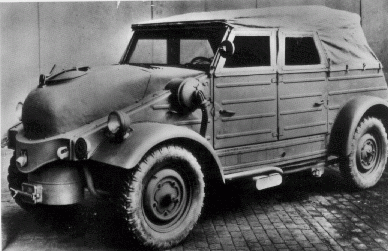Turns out there were cars and trucks in Europe modified to run on wood gas during World War II as a result of severe fuel rationing. According to Wikipedia:
In Germany alone, around 500,000 "producer gas" vehicles were in use at the end of the war. Trucks, buses, tractors, motorcycles, ships and trains were equipped with a wood gasification unit. In 1942 (when wood gas had not yet reached the height of its popularity), there were about 73,000 wood gas vehicles in Sweden, 65,000 in France, 10,000 in Denmark, and almost 8,000 in Switzerland. In 1944, Finland had 43,000 "woodmobiles", of which 30,000 were buses and trucks, 7,000 private vehicles, 4,000 tractors and 600 boats.
There are do-it-yourselfers around today who still tinker with these types of vehicles. I had never heard of this before and thought it was fascinating.
According to the website where the image was grabbed, the Volvo above can reach a maximum speed of 120 km/hr (75 mi/hr) and maintain a cruising speed of 110 km/hr (68 mi/hr). The "fuel tank" can contain 30 kg (66 lbs) of wood, good for a range of 100 km (62 mi). Not good for a cross-country vacation but comparable to electric cars used for short-distance commutes.
So how does it work? Here's a diagram from Wikipedia:
A. Wood, B. Fire, C. Air Inlet, D. Grating, E. Gases, F.Coarse Filter,
G. Filtered Gases, H. Radiator to Cool Gases, I. Cooled Gases,
J. Fine Filter, K. Wood Gas, and L. Air Mixing & Choke.
Generally, you have a tank for wood (anything from logs to wood chips). The wood is heated and charred in the sealed container with limited oxygen input. Chemists call this process pyrolysis. When you burn wood in the presence of oxygen (a fireplace, for example), you produce gaseous H2O and CO2. In pyrolysis, with limited oxygen, you instead get H2 and CO - both flammable gases. The smoke is then filtered (to remove soot and tars - not necessary but results in cleaner emissions) and cooled (to increase flammability of the gases). It's then mixed with a little air and fed into a normal internal combustion engine (you don't really need to modify anything - it will power a standard car engine).
The output from a typical wood gas system consists of the following:
20% Carbon monoxide (CO)
18% Hydrogen (H2)
4% Methane (CH4)
8% Carbon dioxide (CO2)
50% Nitrogen (N2)
The energy content of wood gas is around 5.7 MJ/kg, compared to 44 MJ/kg for gasoline. It's certainly not as efficient (or convenient) as gasoline. But, hey, if times get bad and fossil fuels are in short supply, who knows, it might make a comeback!







The fuel for a wood gas car consists of wood or wood chips (see picture on the left). Charcoal can also be used, but this leads to a 50 percent loss in the available energy contained in the original biomass. On the other hand, charcoal contains more energy, so that the range of the car can be extended. In principle, any organic material can be used. During the Second World War, coal and peat were also used, but wood was the main fuel.
ReplyDeleteThere was a brief mention in this Planet Money Podcast - http://www.npr.org/blogs/money/2011/07/20/138166864/the-friday-podcast-north-koreas-illegal-economy about the fact that North Korea has actually converted a lot of their army vehicles to this to get around the oil embargo. I never quite understood how that worked until your great writeup.
ReplyDelete